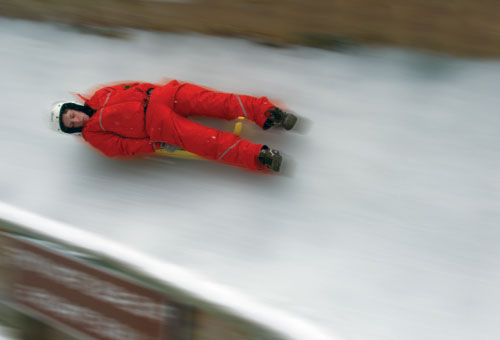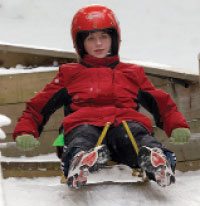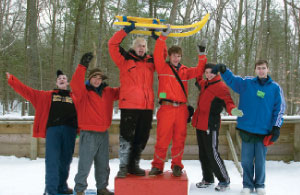Too Fast for Fear
By Cindy Ross
Photographs by Vince Heptig
Lying flat on their backs and reaching speeds of 25 miles per hour, Crew 1716 Venturers zip down a luge track in less than 20 seconds. Who has time to be afraid?
 Jeff Harris braces his body against mounting g-forces as he shoots into a long sweeping turn. |
Venturer Dimitri Munselle grabbed the short sled and climbed the wooden staircase at the Muskegon Winter Sports Complex luge track. The sled, about three feet long, or roughly the length between Dimitri’s shoulders and lower thighs, was his ride to the bottom of the twisting, curling, icy track.
At the starting gate, 780 feet above the finish line, Dimitri tried to remember all the instructor’s advice for a clean run:
Keep relaxed. Steer with your head, shoulders, legs, and feet. But above all, stay flat on your back. Raising your head, even slightly, could send the sled careening side to side on the track and possibly causing it to flip. At 25 miles per hour and two g-forces, that would not be a pretty sight.
Dimitri remembered the question fellow Venturer Brian Sevald had asked, “How do you slow down?”
“You don’t,” instructor Larry Page answered. “There’s no brake on a luge.”
Dimitri was just a little bit anxious. “I’ve got butterflies in my stomach,” he admitted.
A good idea at the time
Only one crew member, Jeff Harris, had been to the track on a previous outing, and he was full of confidence. Emotions among the other Venturers ranged from concerned to terrified.
 Jenny Friday prepares to zoom downhill. |
“Perhaps learning to luge sounded less scary to the Venturers back home in the comfort and security of their planning meeting,” said Crew 1716 Advisor Diane Lynn.
The Detroit-area crew, chartered to the Troy, Mich., consulting firm KSH & Associates, chose the trip to the winter sports complex during their annual program planning conference.
The Muskegon instructors worked hard to reduce the Venturers’ fears. They taught the teens how to steer the luge and fitted them with safety helmets and elbow pads.
Their best advice? Finesse the straightaways. Dig deep and drive hard through the turns. Maintain a constant stomach crunch.
It was a lot to think about. If they were lucky, each Venturer would make four or five runs in the two-and-a-half hours they were allotted at the track.
“You’ll have big fun by the end,” an instructor promised them.
“The first run is nothing but fear and a huge sense of relief when it is over. But after that, you’ll know how the track runs. The second time, you’re a little more confident. By the third run, you’re feeling relaxed in the sled; and the fourth—it’s a blast.”
“I think I’d like it better without the sled,” Steven Emmer whispered.
The first run
“Track is clear,” a voice from the loudspeaker announced.
 Crew 1716 Venturers hoist a luge sled in a mock winners' ceremony. Left to right are Steve Emmer, Brian Sevald, Travis Lynn, Jeff Harris, Jenny Friday, and Dimitri Munselle. |
It was now or never. Dimitri lay back on his sled and grabbed the handholds. The gate opened, and gravity took charge. Sliding forward, he tripped the electronic beam that would time his run to within one one-hundredth of a second.
“Go! Go! Go!” cheered assistant Advisors Fred Lynn and Dave Kelley.
Turn No. 1. “Good head! Good steer!” the instructors yelled.
Turn No. 2. The sled accelerated. Vibrations rattled Dimitri’s entire body.
Keep your eyes open, he thought, but don’t lift your head.
Turn No. 3, the 180-degree hairpin. “Start to turn it!” he vaguely heard. Suddenly he was banked high on the wall. Centrifugal force swung him through the turn, and he leveled out again.
Then it was over. In less than 20 seconds Dimitri had reached the finish line. His heart was racing and adrenaline flowing, but his fear had seemingly evaporated.
“I like speed,” Dimitri said later, grinning. “I love watching the Olympic luge, and now that I’ve done it, too, I have a much deeper appreciation of the sport.”
It is fun
Most everyone was having fun by the end of his or her second run.
The guys listened intently for their times at the bottom of the track and consciously tried to improve.
They enjoyed the challenge of tweaking their run for a faster time.
Brian Sevald said, “It was fun trying to figure out the mechanics, negotiating the track, thinking it through, and having a strategy.”
The girls focused less on competitiveness and more on form and fun.
The teens took several more runs and were eventually finding their groove, but by runs four and five, they were tired. Shoulders got out of balance, and sleds started to skip and then swing back and forth.
By this time, a campfire back in the oak grove campsite sounded like a good idea.
Kim Hunter only made one run and decided luge was not her sport. “I am afraid of heights,” she said.
Still, forcing herself to try the course once was a huge triumph over her fear.
“I wasn’t even going to try it,” Venturer Jenny Friday admitted, as she warmed her hands. “I’m a cross-country runner, and I didn’t want to take the risk of getting injured.
“But when I learned that the track was relatively small compared to the Olympic tracks, I went for it, and I was so glad. It made me stretch beyond my comfort zone and expand my horizons, and that was good.”
Freelance writer Cindy Ross also wrote “Against All Odds” in this issue.
You, Too, Can LugeThere are four luge tracks in the United States: Lake Placid, N.Y.; Park City, Utah (site of the 2002 Winter Olympics); the Muskegon Winter Sports Complex on the shores of Lake Michigan; and a natural ice-path track in Negaunee, Mich. Olympic athletes reach 90 miles per hour and experience five g-forces, but that’s way too fast for the general public. Muskegon’s recreational track is unique in that it is the most publicly accessible luge track in the country. The sole purpose of the winter sports complex is to get kids and adults to try the thrilling luge experience. At a total length of 850 feet, Muskegon’s track is ?th the length of an Olympic track. Constructed of wood, the track has a dirt base. Gravel is used to shape the corners. Once it snows at least four feet, and temperatures drop below freezing, snow is hauled from the parking lot and dry packed into the track. Applying water with a fire hose and shaping with special icing tools creates the pipe shape. Every night, the icing crew arrives to repair and patch the grooves the luges’ steel runners wear in the run. The track snakes over the sand dunes just 1,200 feet from the shores of Lake Michigan and winds through the picturesque hardwood forest of Muskegon State Park. But flat on your back and zooming along at 25 m.p.h., who has time to sightsee? “Our track gives people the Olympic feeling without the Olympic speeds,” executive director Jim Rudicil said. As a result, Muskegon’s track is very popular with Scout troops, Venturing crews, and church groups. Lake Placid and Park City allow the general public to experience a short rocket luge. However, there, you shoot down a straight track and cannot actually steer the sled as you must at Muskegon. |
Venturing and the Olympic Movement
The USOC directs NGB’s of Olympic sports to develop and manage world-class athletes, as well as recruit new athletes. For many NGB’s that means searching for youth as young as Cub Scouts.
NGB’s offer a wealth of program opportunities for packs, troops, and crews. NGB’s have clubs and affiliates that offer introductory, intermediate, and advanced programs related to their sport.
|
January - February 2008 Table of Contents
Copyright © 2008 by the Boy Scouts of America. All rights thereunder reserved; anything appearing in Scouting magazine or on its Web site may not be reprinted either wholly or in part without written permission. Because of freedom given authors, opinions may not reflect official concurrence.
 The Boy Scouts of America has a long and rich partnership with the United States Olympic Committee (USOC) and many members of its National Governing Bodies’ Council (NGBC). Five years ago, when Venturing developed the Quest Award, much of the research, resource recruiting, and suggestions for the award’s requirements were provided by the USOC and NGB staffs.
The Boy Scouts of America has a long and rich partnership with the United States Olympic Committee (USOC) and many members of its National Governing Bodies’ Council (NGBC). Five years ago, when Venturing developed the Quest Award, much of the research, resource recruiting, and suggestions for the award’s requirements were provided by the USOC and NGB staffs. NGB’s call this the Olympic pipeline. NGB’s fill the pipeline by working with the BSA and other similar organizations. Who knows, when a troop or crew enjoys a sled ride at a luge development site or participates in an air-rifle shooting event at a biathlon center, a future gold medal-winner might be identified.
NGB’s call this the Olympic pipeline. NGB’s fill the pipeline by working with the BSA and other similar organizations. Who knows, when a troop or crew enjoys a sled ride at a luge development site or participates in an air-rifle shooting event at a biathlon center, a future gold medal-winner might be identified. To find out more about Olympic NGB’s, including contact information, check the resource section of the Venturing Quest Handbook (BSA No. 33151) or visit the USOC Web site at www.usoc.org. There are listings for both winter and summer sports. These resources make it possible for a young person in your unit to become a part of the U.S. Olympic movement, enjoy a new sport, and stay healthy at the same time.
To find out more about Olympic NGB’s, including contact information, check the resource section of the Venturing Quest Handbook (BSA No. 33151) or visit the USOC Web site at www.usoc.org. There are listings for both winter and summer sports. These resources make it possible for a young person in your unit to become a part of the U.S. Olympic movement, enjoy a new sport, and stay healthy at the same time.